Abandoned places possess a unique allure, beckoning intrepid explorers to uncover the whispers of the past and decode the stories left untold.
The mysterious charm of Spain’s abandoned places lies in the silent narratives etched into crumbling walls, rusted remnants, and deserted landscapes. Spain, with its rich history and diverse cultural tapestry, unfolds a captivating chapter in the world of abandonment.
From inadvertent ghost towns to deliberately unfinished cities, the exploration of abandoned locations in Spain transcends mere curiosity; it becomes a journey through time, unlocking secrets and understanding the intricate threads that weave the nation’s narrative.
In this blog, we go on a compelling exploration, delving into the significance of these abandoned places, unraveling tales of bygone eras and overlooked relics that silently speak of Spain’s enigmatic past. Don’t forget though, to read my blogs Discover Spain’s Rich Culture and History: With Insider Tips and Barcelona’s Best-Hidden Gems for an Authentic Experience.
Contents
- Abandoned Towns by Mistake
- The Unfinished Cities in Spain
- Can You Buy a Town in Spain?
- Abandoned Houses in Spain: Numbers and Causes
- The Underground City of Spain
- Haunted and Mysterious Places in Spain
Abandoned Towns by Mistake
In Spain’s history, there exist haunting tales of towns left behind, not by design, but by a twist of fate. These unintentional ghost towns bear witness to the ebb and flow of life, where circumstances led to the abandonment of once-thriving communities.
The Vanishing Villages
These vanishing villages stand as silent witnesses to the intricate dance between history, societal changes, and environmental challenges. While their populations may have dwindled, the stories embedded within their walls continue to captivate those who seek to unravel the mysteries of Spain’s abandoned places. Whether attracting tourists or remaining hidden in quiet isolation, these villages tell tales that transcend time.
Granadilla, Extremadura:
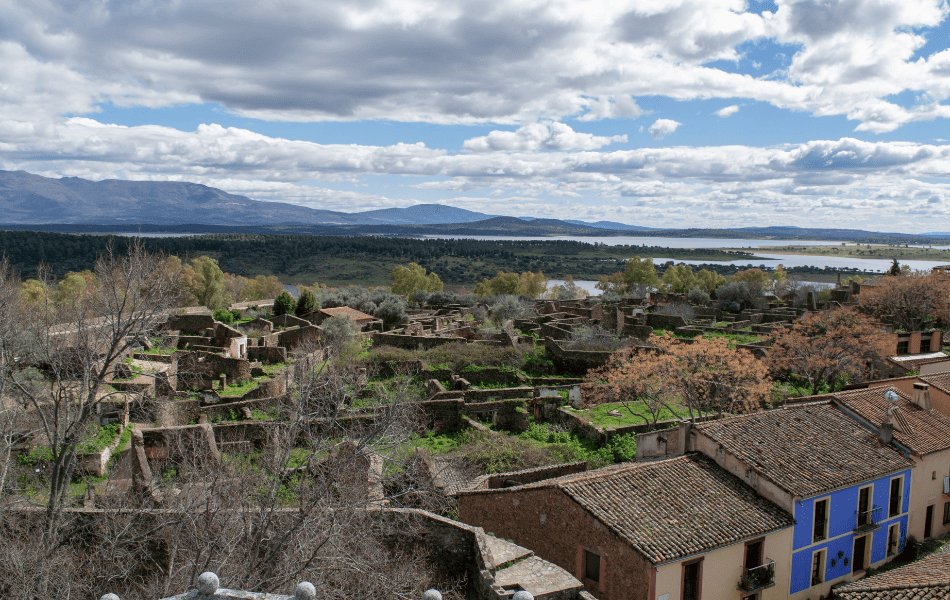
- Date of Vanishing: Granadilla was depopulated in the 1960s.
- Reasons for Abandonment: Economic shifts and changing agricultural practices led to a decline in population. The construction of a reservoir submerged parts of the town, further accelerating its abandonment.
- Tourist Attraction: Granadilla, now managed by the Junta of Extremadura, has been partially restored. It attracts tourists seeking a glimpse of the past, offering a unique blend of history and natural beauty.
Ainielle, Pyrenees:
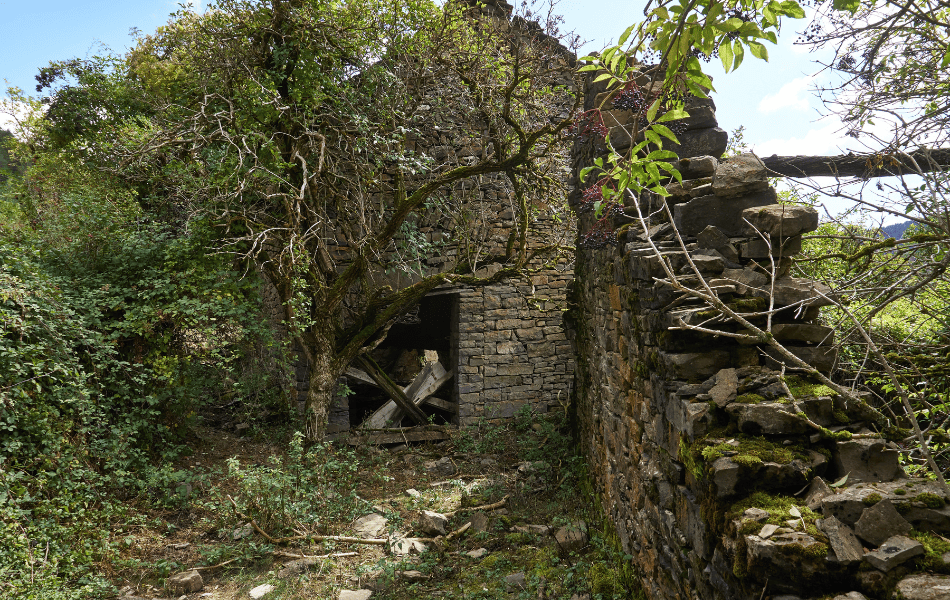
- Date of Vanishing: Ainielle saw a decline in the mid-20th century, with the last inhabitants leaving in 1970.
- Reasons for Abandonment: A combination of economic hardship, depopulation, and the allure of urban life contributed to Ainielle’s abandonment. The isolation of the mountain village made it increasingly difficult for residents to sustain their way of life.
- Tourist Attraction: Ainielle remains a picturesque ruin in the Pyrenees, drawing hikers and history enthusiasts who appreciate its serene atmosphere and the melancholy beauty of its abandoned stone houses.
The Yellow Rain is a divine story of one man who decides to remain in Ainielle, Pyrenees.
Economic Downturns
These examples underscore the profound impact of economic downturns on small towns, where once-booming industries faced decline, triggering a cascade of events leading to depopulation and transformation of Spain’s abandoned places. While these towns may not be traditional tourist destinations, the remnants of their economic histories offer a unique lens through which to explore the challenges faced by communities in the wake of industrial decline.
Rio Tinto, Huelva:

- Date of Vanishing: The economic downturn in Rio Tinto began in the mid-20th century, with a significant decline in the latter half of the century.
- Reasons for Abandonment: Historically sustained by mining activities, particularly copper and other minerals, Rio Tinto faced a severe economic downturn as mining operations dwindled. The exodus of residents seeking employment opportunities elsewhere led to a decline in population and the transformation of the town into a shadow of its former self.
- Tourist Attraction: Rio Tinto is not a mainstream tourist attraction, but the remnants of its mining infrastructure and the unique Martian-like landscape have drawn the interest of those intrigued by industrial archaeology and unusual terrains.
Puertollano, Ciudad Real
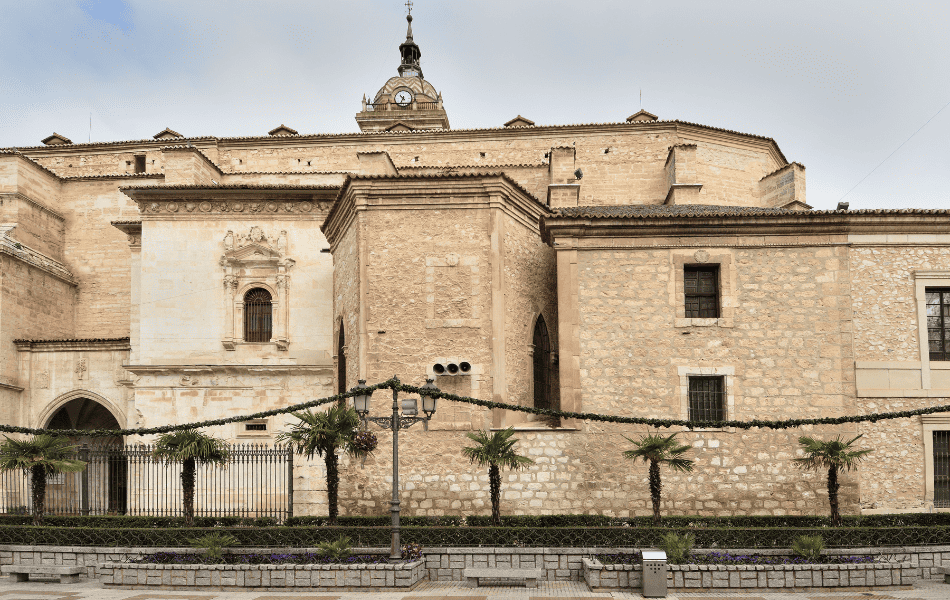
- Date of Vanishing: Puertollano faced economic challenges starting in the 1980s.
- Reasons for Abandonment: A once-thriving industrial town, Puertollano’s economic downturn was fueled by the collapse of the coal and steel industries that were the backbone of its prosperity. The closure of several key factories and mines prompted a mass exodus of residents in search of livelihoods, leaving the town grappling with depopulation.
- Tourist Attraction: Puertollano is not a designated tourist attraction, but its industrial heritage has sparked interest among history enthusiasts. The town is striving to reinvent itself by promoting its historical and cultural assets.
Demographic Shifts
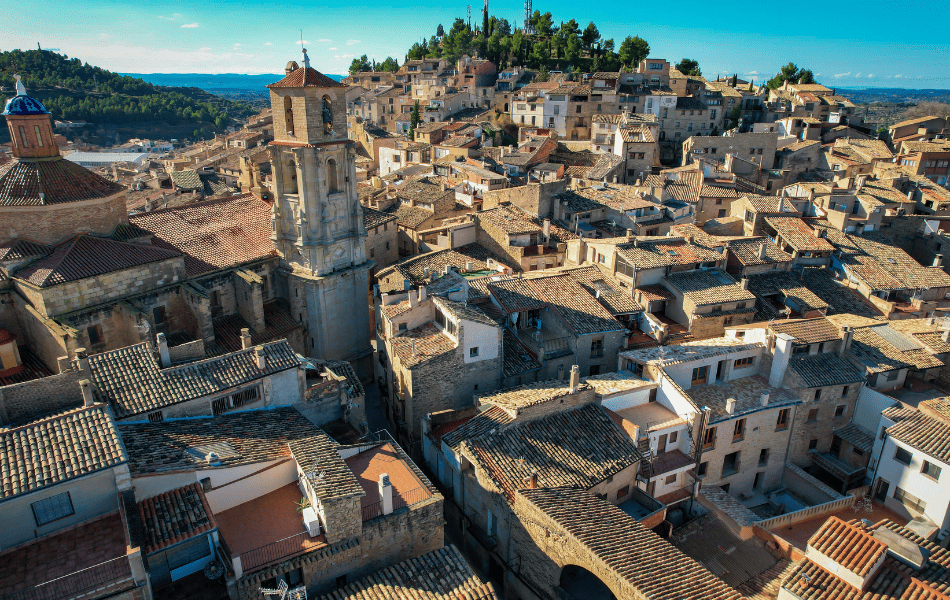
Demographic shifts in small towns echo the complex dance of generations. As younger residents migrate to urban centers in search of opportunities, a domino effect transforms the social fabric. The exodus leaves behind aging populations grappling with the challenge of sustaining infrastructures meant for larger communities. Schools echo with emptiness, and once-bustling main streets whisper tales of youth. The quietude that settles over these towns becomes a poignant reminder of the intricate interplay between demographic dynamics and the resilience of communities in the face of change.
An example of a town in Spain experiencing demographic shifts is Calaceite in the province of Teruel. Like many rural areas, Calaceite has faced a decline in its population due to youth migration to urban centers. A hotel you can stay at Boutique Hotel Cresol a little charmer hotel with 6 rooms built on an ancient oil mill from the early eighteenth century.
The Process of Unintentional Abandonment
The unintentional abandonment of towns in Spain’s abandoned places unfolds through a gradual process. Initially, signs manifest as population decline accelerates, local economies falter, and services diminish. Infrastructure, once vibrant, succumbs to neglect, displaying visible decay. As the inexorable shift continues, these indicators coalesce, marking the irreversible transition into ghost towns, where echoes of vibrant communities linger in the remnants of what once thrived.
The Unfinished Cities in Spain

One of Spain’s most captivating tales lies within the ruins of Belchite, a city frozen in time. The Unfinished City, abandoned during the Spanish Civil War (1936-1939), is a poignant testament to the conflict’s toll. Intended as a modern urban center, Belchite’s construction halted abruptly due to wartime destruction. The scars of battle endure in its skeletal structures, embodying the city’s unfinished destiny. Exploring Belchite offers a profound glimpse into the consequences of war, with shattered buildings and silent streets preserving the echoes of a city thwarted by history’s turbulent forces. The unfinished symphony of Belchite stands as a haunting monument to a bygone era. The hotel to stay at is Hotel El Capricho de Goya.

Ciudad Valdeluz, envisioned as a thriving urban haven, remains an unfinished project due to economic downturns and the burst of the Spanish real estate bubble in the late 2000s. The ambitious development, located near Guadalajara, faced financial crises that halted construction. The dream of a bustling cityscape with modern amenities faded as investments dwindled. Today, Ciudad Valdeluz stands frozen in time, a testament to the unforeseen economic challenges that can disrupt even the most ambitious urban visions.
Can You Buy a Town in Spain?
The notion of purchasing an entire town in Spain has intrigued investors and dreamers alike. Legal and logistical challenges, however, accompany such endeavors. Spanish property laws, local regulations, and community considerations pose hurdles. While instances of towns being listed for sale exist, navigating the intricacies of ownership transfer and redevelopment is complex.
One example of an entire abandoned Spanish village that is up for sale for €260,000, is Salto de Castro in Zamora province has 44 houses, an inn, and a church.
Abandoned Houses in Spain: Numbers and Causes
Abandoned houses in Spain number in the hundreds of thousands, with estimates ranging from 3-4 million vacant homes. Economic downturns, exacerbated by the 2008 financial crisis, and rural depopulation contribute significantly. High unemployment and changing lifestyles have left many homes deserted, particularly in rural areas, echoing the challenges faced by these communities, adding to Spain’s abandoned places.
The Underground City of Spain
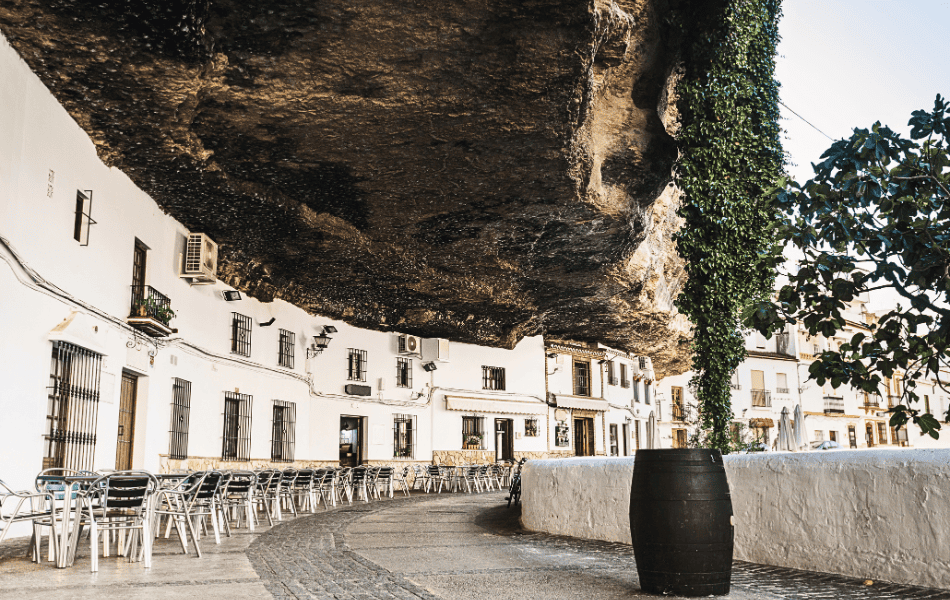
Beneath Spain’s surface lies a captivating mystery – the underground city of Setenil de las Bodegas. Carved into sheer cliffs, this ancient enclave dates back centuries, offering shelter from both natural elements and historical conflicts. Serving as a fortress for early inhabitants, the city’s cave-like structures evolved into homes and businesses. Legends tell of strategic advantages during Moorish invasions, and the sunlit streets seamlessly blend with the rock. Setenil de las Bodegas stands as a testament to human ingenuity, a subterranean marvel weaving history, purpose, and myth into the very fabric of this remarkable underground realm.
Haunted and Mysterious Places in Spain
Bélmez Faces, Bélmez de la Moraleda
- In the quiet town of Bélmez de la Moraleda, mysterious faces appeared on the floor of a woman’s home in 1971. These unexplained, ever-changing visages sparked paranormal speculation. Legend has it that the faces represent tormented souls, and efforts to remove or cover them proved futile. The Bélmez Faces phenomenon has endured, captivating believers and skeptics alike with its eerie, supernatural enigma.
The Hanging Houses, Cuenca
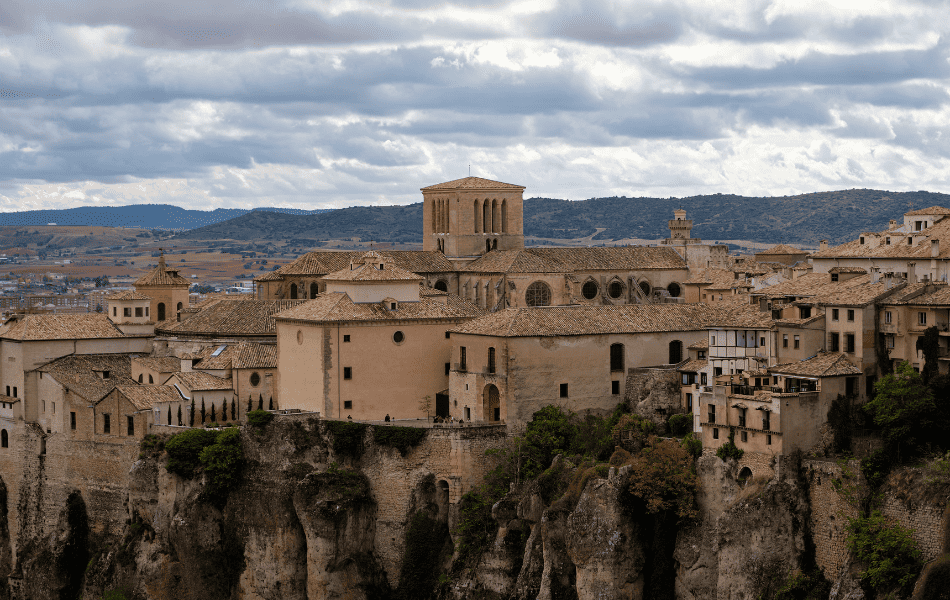
- Perched precariously on the edge of a gorge, the Hanging Houses of Cuenca evoke an otherworldly charm. With roots dating back to the 15th century, these structures are rumored to be haunted by the spirits of disgraced knights. Local lore recounts tales of tragic love and betrayal, contributing to the lingering sense of mystery that surrounds these gravity-defying architectural wonders.
Conclusion
In the weave of Spain’s landscapes and histories, the exploration of abandoned places, mysterious legends, and haunted realms reveals a captivating narrative. From unintentional ghost towns bearing the weight of economic downturns to the unfinished echoes of Belchite’s wartime legacy, each abandoned locale speaks of a complex interplay of time, circumstance, and resilience. The demographic shifts, economic challenges, and the haunting beauty of underground cities illuminate the dynamic nature of Spanish communities. Exploring Abandoned Places in Spain is most certainly adventure travel as it is exhilarating, adrenalin charging, and an enlivening holiday.
As we navigate the winding streets of Bélmez, stand before the Monte Cristo Castle, or marvel at the Hanging Houses, we bear witness to the enduring spirits of Spain’s enigmatic past, echoing across silent ruins and whispered legends. These stories, embedded in the very stones of ancient cities and abandoned hamlets, invite us to ponder the delicate dance between creation and decay, leaving an indelible imprint on the collective memory of a nation rich in history, mystery, and haunting beauty.
6 thoughts on “Spain’s Abandoned Places: a Journey Through Time and Mystery”
Comments are closed.
Recent Posts
Discover insider tips to find cheap flights from the UK, save on easyJet, Ryanair & BA, and score the best weekend and last-minute deals. Why You’re Paying Too Much for Flights Most UK...
Discover the sounds of travel, from laughing kookaburras to market chatter, church bells to ocean waves - a journey heard as much as seen. It always starts with a sound. The other day, walking...


Hey! Do you use Twitter? I’d like to follow you if that
would be okay. I’m definitely enjoying your blog and look forward to new updates.
Hi Declan. Sorry I am not using Twitter at this stage.
Spot on with this write-up, I absolutely believe this web site needs a great deal more attention. I’ll probably be back again to read more, thanks for the info!
Spain on the bucket list for next year. This helps hugely.
May I simply just say what a relief to discover a person that truly knows what they’re discussing on the net.
You actually understand how to bring an issue to light and make it important.
A lot more people have to look at this and understand this side of the story.
I was surprised you aren’t more popular because you most certainly have the gift.
Many thanks for your lovely comment!